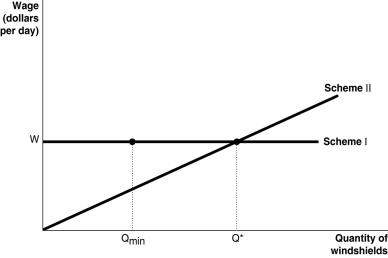
Figure 14.5

Figure 14.5 shows two different compensation schemes for the Safelite Glass Corporation, an installer of auto glass windshields. Under Scheme I, the firm pays a consistent wage of $160 per day based on an 8-hour workday. Qmᵢn represents the cut-off point under the hourly-wage system: if a worker installed fewer than Qmᵢn windshields, the worker got fired. Scheme II represents a piece-rate scheme with an earnings floor: no worker would get less than $160 per day (for an 8-hour workday) and would have to produce at least Qmᵢn. For any output level beyond Q* the worker earned an additional $20 for each unit produced.
-Refer to Figure 14.5.Suppose Qmᵢn = 2 windshields and Q*=5 windshields.Under Scheme II, a worker has to install Q* windshields before she earns an additional $20 per windshield installed.What is a potential problem with this scheme?
A) Workers might be more concerned with increasing output beyond Q* and less concerned with the quality of their work.
B) Any increase in output between Qmᵢn and Q* benefits the employer only.
C) It violates labour laws because workers are not compensated for output between Qmᵢn and Q*.
D) Workers have no incentive to produce output to between Qmᵢn and Q*.
Correct Answer:
Verified
Q134: Figure 14.5 Q218: The marginal revenue product of capital is Q226: Despite evidence that companies will find it Q230: Which of the following is a reason Q234: A successful compensation scheme Q243: A firm might prefer a commission system Q248: Economic rent is defined as Q254: Which of the following statements regarding equilibrium Q256: When workers are paid on a piece-rate Q258: What is personnel economics?
![]()
A)the
A)must pay workers with
A)what you pay
Unlock this Answer For Free Now!
View this answer and more for free by performing one of the following actions

Scan the QR code to install the App and get 2 free unlocks

Unlock quizzes for free by uploading documents